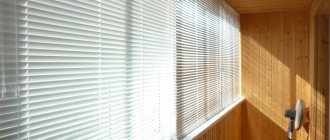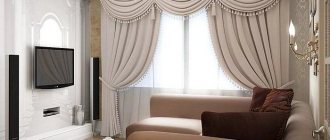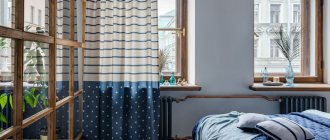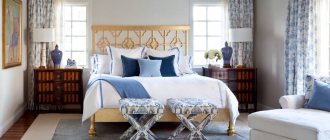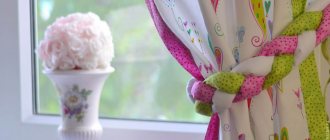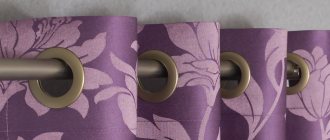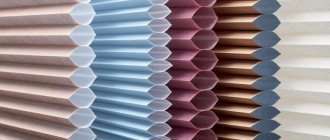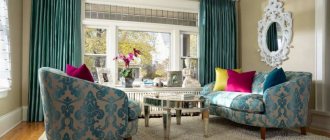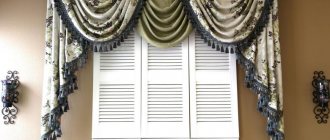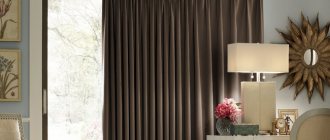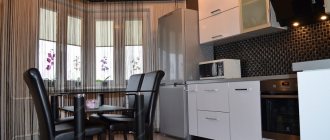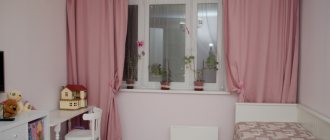The design of a corner window requires taking into account a lot of features of the opening; every little detail is important here: what style of curtains to choose, how to choose and hang the cornice correctly, how to adjust the shape of the opening and fit the design into the overall picture of the interior.
Features of corner windows
This type of window openings differs from standard rectangular designs.
Its features:
- wide viewing angle, allowing you to better see the landscape outside the window;
- non-standard, sometimes asymmetrical shape, making it difficult to select cornices and curtains;
- different dimensions: from small triangular openings on a sloping wall to panoramic windows;
- high ability to transmit light, which visually expands the room and emphasizes light shades in its design;
- variety of shapes: triangle, trapezoid, semicircle, “house”, beveled rectangle, etc.
The features of windows should be taken into account when choosing cornices and curtains. This will help you find the optimal solution for the design of the opening.
Types of corner windows
Window openings located in corner areas are divided into several types. For each of them, different types of curtains, fixtures and decorations are suitable.
Bay window
A bay window is a convex part of a room extending beyond the main facade. The windows in it visually expand the room, making the interior more spacious and richer.
Bay window structures come in different shapes: round, triangular, rectangular, multifaceted.
They are glazed, either completely or partially, and decorated with beams, partitions and other decorative elements.
Single
Windows of this type are installed on attic floors and in other places where there are sloping or asymmetrical sections of walls. They come in different shapes and sizes. Most often there are triangular and trapezoidal openings, less often - rounded, beveled in the shape of a house, figured, etc.
Two windows in the corner of the house
This is the type of opening most often found in spacious rooms. In this case, 2 windows touch at the junction of the walls, forming a single structure. It makes the room lighter, more spacious and looks especially impressive in combination with adjacent panoramic windows.
Briefly about cornices
It is clear that conventional models of cornices for corner compositions are not the best option. There are no fastenings for the fabric at the junction, so it will sag unsightly, spoiling the whole look. The situation will be corrected by flexible profile cornices that can easily take the desired shape, or corner models with special mating parts. If the cornices have an external rail, then they are attached to the ceiling, covered in front with a decorative baguette, or “recessed” in a plasterboard niche.
Hang simple curtains on the cornices for the corner window. If you want to place blinds on corner windows, it is better to contact a company that manufactures and installs blinds, where they will recommend the most suitable, and possibly individual, option for your windows.
Principles for choosing corner curtains
When selecting curtains for a corner window, you should take into account factors such as the size of the opening, its location, the general style and decor of the room.
Tips and recommendations for choosing:
- Bay windows are most often installed in large, bright rooms. Curtains made of expensive textured materials (satin, silk) with bright colors and rich decor will help to emphasize the spaciousness and luxury of the room. Multilayer curtain compositions in which curtains are combined with tulle and lambrequin would look appropriate.
- It is best to decorate panoramic windows in the corner of the house with 2 identical straight curtains, combined into 1 solid composition using a lambrequin and 2 thick decorative curtains at the corners of the openings.
- Blinds, English or Roman blinds look good on sloping asymmetrical windows. Their length is adjustable in individual sections of the canvas, which allows you to adjust the shape of the curtains to the characteristics of the opening.
- Small triangular or trapezoidal windows are completely curtained. Fabrics for curtains are chosen to be light, airy and let in a lot of light, otherwise they will look too gloomy.
- The house-shaped structure is decorated with simple, even products that are attached to the transition line of the windows. The triangular part is left open or covered with decorative tulle attached to rings or loops near the ceiling.
- Original fan-shaped curtains look good on round or semicircular windows. A veil or transparent tulle will help to emphasize the lightness and smoothness of their shape.
Curtains of an unusual cut will help highlight the features of a non-standard shaped window. Asymmetric folds are created on them using tiebacks and magnetic clips. Sometimes the fabric is attached to rings or hooks located at the top or side of the main cornice: this helps to visually unite the parts of the opening with the wall, making them part of a single composition.
Straight windows in the corner of the house or on the slope of the roof are decorated with a combination of light rectangular curtains and thicker curtains on the sides. The decor is placed along the edges of the composition, leaving the central part simple and discreet.
Indoor curtain design
The choice of cornice and curtains for a corner window depends on the size of the room, its general style and purpose. Successful design solutions for a spacious living room will not suit a small kitchen, and vice versa, so window decor is selected individually.
Kitchen
This room most often has a small area, so heavy curtains made of textured fabrics look out of place in it. It is better to give preference to light, translucent curtains in delicate tones: green, yellow, pink, beige.
Short curtains that do not reach 10-15 cm from the window sill are good: a curtain that is too long will collect dirt.
Small bows, garters, ribbons, and fringes are suitable for kitchen decor. A floral or geometric pattern would look appropriate on a curtain.
Living room
The selection of curtains in this case depends on the overall style of the room. For large, spacious living rooms, heavy, textured curtains that fall to the floor in beautiful folds are suitable.
In small rooms, light curtains in combination with tulle or veil look good. If you plan to make an accent on the window opening, use complementary tones: gold or silver with green, red with pink, white with coffee, blue with lilac.
In a room decorated in a classic, baroque or empire style, complex curtain compositions with figured lambrequins, multi-layered fabric, and rich decor are appropriate.
In a modern minimalist living room, simple Roman or roller curtains, blinds, blackout curtains, and photo curtains look good. In order for curtains to fit better into the room, their color and texture should be combined with the finish of the furniture.
Bedroom
In the sleeping room you need to create a calm atmosphere that does not disturb the resting person, so it is better to avoid curtains in bright colors. Textiles in calm shades of blue, purple, green, and pink look appropriate.
Neutral tones remain unchanged classics: gray, coffee, beige, white, cream. The fabric for curtains should be thick and does not allow light to pass through.
For bedroom decor, lambrequins, pompoms, tassels, bows, ribbons and cords are suitable. Geometric or floral patterns on fabrics look appropriate, especially if they are combined with furniture decoration, carpets, and bed linen.
Children's
For this room, you should choose curtains made from safe, environmentally friendly materials: cotton, linen. Shortened compositions that do not reach the floor are preferred. The color of the curtains is selected taking into account the child’s character.
Fabrics that are too bright will distract attention, while pale and cold ones will cause boredom, so you need to maintain a balance. Curtains in rich, but not flashy shades of green, pink, blue, and orange are recommended. They are complemented with translucent tulle.
A rich decor of curtains is appropriate in a child's room: bows, ribbons, figured lambrequins, appliqués and drawings featuring animals, birds, characters from books or cartoons. It is better to avoid small and easily lost accessories.
Types of curtains
Corner windows are decorated with curtains of different types. Classic curtains, transparent tulle, thick blinds, unusual items made of threads, beads and glass beads: everything is in demand in rooms of different purposes and styles.
Classic type
It is a flat, straight panel attached to the top of the window. It hangs freely or is folded using tiebacks, ribbons, braid and other decorations.
French
They consist of a canvas divided into several sections. Each of its segments is decorated with lush folds. The curtain is equipped with a lifting mechanism: the higher it is pulled, the more voluminous the drapery becomes.
Italian
Consist of 2 panels connected to each other at the top. They are attached to the edges of the window using tiebacks, ribbons, cords, forming folds falling in a semicircle, framing the opening on both sides.
Roman
They are a flat sheet with a built-in lifting mechanism. When pulled, they gather into even, neat folds.
Austrian
A lush, elegant type of curtains made from lightweight fabrics. When lifted, it forms semicircular volumetric folds in the lower part of the canvas.
Rolled
They are a dense fabric without folds, equipped with a lifting mechanism. It is attached to the window frame, so it does not take up extra space. When lifted, the curtains gather into an invisible roll at the top.
Blinds
They do not consist of a single piece of fabric, but of separate strips. Made from textiles or hard materials such as plastic, wood, bamboo. The height and tilt of the blinds are controlled by a special mechanism that allows you to change the level of light in the room.
Pleated
Curtains of this type are attached to 2 beams: upper and lower. The canvas forms an accordion of fabric between them. Pleated rods come in all sizes and shapes, which is convenient for non-standard corner windows.
Methods for attaching curtains to corner windows
Options for attaching curtains to a corner window:
- On 2 cornices located on the sides of the opening. This mount is suitable for windows of triangular and trapezoidal shapes. The curtains are fastened loosely, and their lower parts are pulled to the sides with garters or clamps.
- For rings, buttons, magnetic clips. They are placed along the top of the opening in accordance with the bending angle, after which the curtains are secured. This method is convenient because it allows you to effortlessly curtain a window of any shape and emphasize its unusualness.
- On a multi-segment or rounded cornice. It is attached to the ceiling, after which freely flowing curtains are hung. This decor looks especially impressive on large, tall bay windows.
- On the ceiling. The curtains are fixed to a special ceiling structure, after which the shape of the flowing fabric is adjusted to fit the opening using tiebacks, ties and other decor. This mounting method is suitable for decorating large panoramic windows.
- For 1 standard cornice. It is placed obliquely (for oblique openings) or hung slightly below the top of the window, leaving part of it open (for triangular, trapezoidal structures). This decor makes the room brighter and more spacious.
- On the window frame. This mounting method helps save space and is most suitable for blinds, Roman shades, and blackout. The disadvantage is that such products for corner windows will have to be made to order.
Curtains on corner openings most often hang freely, without unnecessary folds or draperies. Sometimes their shape is carefully corrected using tiebacks, hiding sharp corners and irregularities of a non-standard design.
Design of a corner room with two windows
The curtain for the curtain should be chosen as carefully as possible so that it can emphasize the overall interior, the style of the room and, most importantly, the original shape of the window.
To make the right choice, you need to rely on some criteria, namely:
- Installation method;
- Material of manufacture;
- Length and width;
- Method of fastening curtains;
- Style;
- Design;
- Decor.
Matching Decorations
Various types of accessories are suitable for decorating a corner bar. Beams for unusually shaped openings are made strong and rigid, so they are often decorated with heavy fabrics and large decorations.
Lambrequins
The most common decoration of the cornice, which is a horizontal drapery that falls onto the window from above on top of the curtains. Lambrequins can be soft and hard, straight and curly, freely falling on the curtains or holding a clear shape. They are produced in different colors and textures.
A long lambrequin on a triangular or trapezoidal window will hide irregularities and make the opening appear rectangular, while a short one will emphasize the unusual curly shape. Therefore, you should choose the size of the jewelry depending on the purpose.
Swags
A type of drapery that consists of semicircular folds hanging down. Looks impressive on both large and small windows. Used alone or in combination with a lambrequin. Swags are appropriate for triangular, trapezoidal, and beveled openings. They help smooth out sharp corners while emphasizing the unusual design.
Ties
A long decoration consisting of several folds overlapping each other. The shape resembles the item of clothing of the same name. Attached to the cornice, most often together with a lambrequin. Focuses attention on the upper part of the figured window, emphasizing its unusual shape.
Nuances of designing triangular window blinds
In interiors of minimalism, hi-tech, loft, techno, it is more appropriate not to smooth out non-standard architectural geometry, but to emphasize it. Slat and pleated blinds are ideal for this.
Slat blinds for non-standard windows
Vertical blinds with triangular openings look more harmonious than horizontal ones. It is advisable to install horizontal blinds on small frames and separate sections. On large openings it is more convenient to use vertical blinds.
Pleated blinds for triangular windows
Pleated blinds are a corrugated panel that folds together like an accordion when you need to open the shutters.
The accordion-style bellows design makes it possible to produce pleated openings to fit gaps of any configuration, emphasizing their unusual shape. The width of the folds varies from 1 to 5 centimeters. For standard-sized glass, and especially small ones, it is not recommended to choose blinds with large folds. In wide light, a large fold looks more harmonious than a small one.
Folds can be horizontal and vertical. The first ones should be chosen for openings in the shape of an elongated (rectangular) triangle. The “squat” silhouette has vertical folds stretched upward. It is more convenient to cover a small gap or section with blinds with radial folds: in the open position, they will be assembled like a fan in one corner and straightened at the opposite edge.
Fashion trends
Modern trends in corner window decoration encourage the use of bright prints and unusual patterns. Interesting geometric patterns will help to emphasize the unusual shape of the opening, visually expand it, and hide imperfections.
Photo curtains do not go out of fashion either: a design that fits into the non-standard shape of the window will add freshness and originality to the interior.
Another design trend is the desire for nature and naturalness. Curtains made of light, natural fabrics with plant prints are in demand. Curtains made of bamboo, weaving, and wicker will help you decorate your window in a more original way. They are decorated with shells and artificial flowers.
In modern styles, practical products are trending: blinds, Roman blinds. The simplicity of the design allows them to be adjusted to fit a corner window of any shape.
The color design of the curtains is dominated by pastel shades: mint green, blue, milky orange, lilac, yellow. They are diluted with bright details for accents.
In the interior
Due to the unusual design, decorating corner windows with curtains often causes difficulties, so we suggest looking at the most interesting ideas in photo examples.
A short lambrequin connecting the corner windows allows light to enter the room. This solution is relevant for shaded spaces or for decorating terraces. In the bedroom and living room, in order to create a comfortable atmosphere for relaxation, it is additionally recommended to hang tulle, compact roller blinds, Roman blinds or horizontal blinds.
Design Tips
Choosing the right curtains will help highlight the advantages and hide the shortcomings of the window.
Design tips for selection:
- Large horizontal stripes visually expand the window, while vertical stripes increase its height.
- Light, translucent curtains visually make the room lighter and more spacious.
- Small prints and patterns on the canvas narrow the space, while large ones expand it.
- Textured fabrics that fall in heavy folds add luxury to the interior, but when used in small rooms they make them even more cramped and oppressive.
- The edging of the curtains visually expands the window and emphasizes its unusual shape.
- Gradient coloring of long curtains visually raises the ceiling.
- Selecting curtains that are 1-2 shades brighter than the wallpaper visually makes the room warmer, and darker curtains (compared to the walls) make it colder.
All elements of the curtain composition, from cornices and curtains to secondary decor, must be combined with each other in color, pattern, and general style. This is the only way the design of the corner window will turn out beautiful and harmonious.
Colors and materials
The colors of the curtains are:
- plain;
- with pattern;
- with an image.
When choosing colors, you should focus on the color of wallpaper or furniture, especially upholstered furniture.
There are fewer problems with matter without patterns. This look looks good in a variety of draperies, regardless of their length. To liven things up, you can use lambrequins, tassels, and garters that are also monochromatic, but the color matches the main fabric or has a contrast with it.
Curtains for corner windows should not visually blend with the color of the wallpaper. The shade of the material is chosen several tones lighter or darker.
It should be remembered that straight models that use the entire height of the room visually increase the space of the room. Short options are appropriate in the kitchen and children's room.
Popular materials for single-color curtains on a corner window:
- linen;
- silk;
- velvet;
- atlas;
- jacquard;
- organza.
Natural materials are preferred. They are environmentally friendly and do not collect dust.
